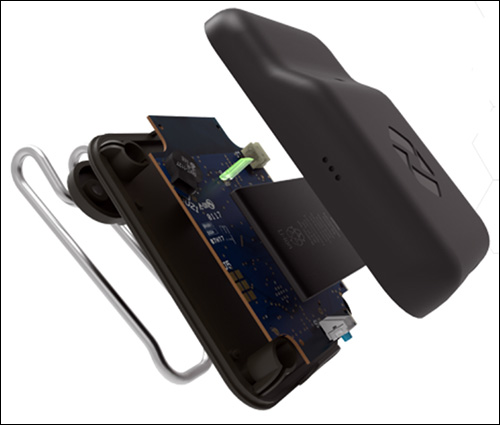Hundreds of workers come and go to and from a busy construction site in New York City each day, from a dozen or more different contracting companies. Managing which individuals are at which locations, and when, has traditionally involved manual head counts or bar-code scans, at best.
Lettire Construction recently adopted Internet of Thing (IoT)-based technology, using active RFID, that not only automates the identification of individuals and the companies they work for as they move around its work sites, but also tracks workers’ activity and reduces the risk that anyone is injured.

The Spot-r worker safety system, provided by Triax Technologies, allows the construction company to identify employees wearing Spot-r IoT sensors, and to connect workers and management onsite in the event of an emergency. With the technology in place, Lettire reports that it has achieved total digital worksite visibility, improved communication and safety, and reduced the amount of time personnel spend tracking down people and information. Spot-r also helps Lettire to meet city jobsite compliance regulations, and provides historic data that can be used to create safer, more efficient worksites.
Lettire builds sustainable and affordable multi-family housing and mix-use properties in New York and the Tristate area, says Bernard (Bernie) Ruf, Lettire’s director of operations. The company is using the Spot-r system at its 205,000-square-foot, 12-story Acacia Gardens project, Ruf says—a new brick building on the corner of East 120th Street and First Avenue in East Harlem. The development will create 179 new affordable homes for residents with low and extremely low incomes, some of whom were formerly homeless. Going forward, Ruf says, the Triax technology will be utilized at all of its construction projects.
When it comes to access control in New York City projects, Ruf says, there are many layers of control and documentation required. Managers must track who is onsite at any given time, the companies they work for and the training they have had. Access to a site can also expire due to safety training requirements, for instance, so Lettire must ensure that no one is onsite whose authorization is out of date.
For access control, Ruf says, “We already have photo ID cards” that can be scanned, providing a record of who reported to work at a particular site, and when. The Spot-r system, he explains, “doesn’t replace that—it kicks it up a notch.”
Spot-r consists of 900 MHz active proprietary RFID sensors about the size of a traditional beeper, as well as receivers known as nodes. These, says Chad Hollingsworth, Triax Technologies’ CEO, create a proprietary mesh network.
The sensor devices can be worn by a worker, and each has a rechargeable lithium battery built into it. They also come with an altimeter, an accelerometer and a gyroscope to identify an individual’s movement, direction and impact in case of a fall. Each device contains an infrared sensor as well, to confirm that it is being worn.
The nodes installed around a worksite are about half the size of a lunch box, the company reports. They can receive transmissions from sensors at a distance of up to 1,000 feet in an open environment, or 200 feet in a dense indoor environment. An installation can also employ Triax boosters that forward data to the nodes. The nodes operate in a mesh network, with some of those nodes using a cellular connection to forward data to a cloud-basedserver, where software integrates that information with a company’s management software.
Typically, each sensor is set to beacon every 10 seconds. Its transmission is then received by up to four of the closest receivers.
At the beginning of a project, Lettire and its subcontracting workers proceed to a site safety trailer for orientation. Each individual is given a picture ID once he or she has completed training, and that person’s information is input into Lettire’s Procore management software which helps Lettire manage and ensure safety compliance.
When workers arrive on site, the security guard scans the badge and assigns that person a Spot-r Clip which is stored with that employee’s ID in the software. The software creates a historical and real-time record of worker activity and safety incidents, and management can use the data to view the total number of workers by floor and zone on the data dashboard.
The solution allows Ruf and other managers to view the activity on the worksite in real time, and if a potential incident takes place, they can receive an alert. For instance, if a Spot-r detects a sudden fall, managers will receive an alert indicationg when and where the problem occurred, whic worker was affected, as well as the distance of the fall; which they can use to help protect against potentially fraudulent claims. The software’s algorithms can also determine whether the data is indicative of a fall, or if the worker might have simply dropped the device.
There have not been any accidents onsite since the system was taken live, Ruf reports, but the company has performed some simulations. The firm tied a sensor (belonging to a worker named Jose) to a cinder block, then dropped it from a second floor. “An alert came in that said Jose fell twelve feet and four inches,” Ruf says.
The company is currently working with a contractor-controlled insurance program, for which it insures the work of all its contractors, and that means there are very strict rules regarding activities onsite. The company has been working with major insurance companies, Ruf says, representatives of which have toured the worksite and have seen the Spot-r system in use. Insurance reps who viewed the system included risk-management personnel, as well as underwriters, he says, and they indicated that they were impressed with the technology.
Since the system was taken live, Ruf says, it has been well received by the subcontracting companies. “The subs love it,” he states, “because with the system, their productivity goes up.” Workers are less inclined to take long or unauthorized breaks from work, and the work is being done more efficiently.
According to Hollingsworth, employees benefit from the technology by knowing they will have support in the event of an emergency. Each Spot-r device comes with a self-alert button that a worker can press and hold for two seconds, in order to signal that he or she needs help. A site superintendent will then receive that alert, along with the individual’s identity and location.
Ruf says the system is also being tested with monthly mustering exercises, in which the software can be used to view who is still on-site at any given time.
What’s more, Hollingsworth adds, the technology can provide analytics, such as where employees typically work, for instance, and when they should be re-assigned, in order to make a project more productive. The collected data can be shared with subcontractors as well as project owners, so that everyone involved can view what is happening onsite at any given time.
Currently, Lettire reports, the Spot-r system has been deployed or is being piloted at several worksites throughout North America.


